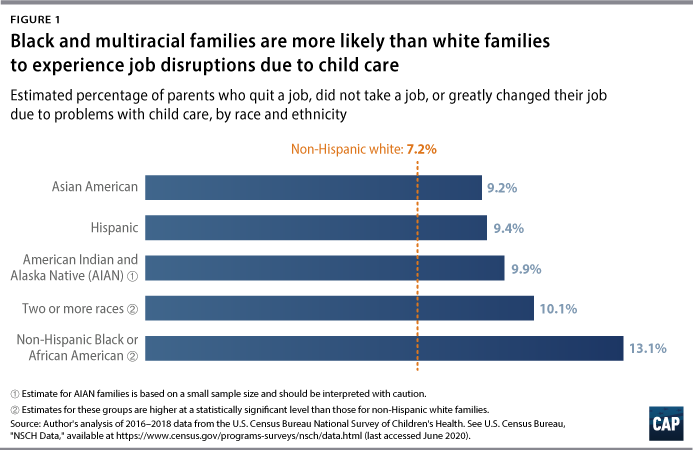
New Analysis: Parents of Color Struggle Most During COVID-19 Crisis to Access, Afford Child Care
This week, the Center for American Progress released sobering new analysis of the child care industry that found decades of occupational and residential segregation have left communities of color at a disadvantage in the changing work environment created by the COVID-19 pandemic. With less access to telework and flexibility that have afforded millions of parents to care for their young children during this health crisis, workers of color, many of whom are on the frontline of this pandemic, have been forced to make difficult decisions about returning to work or providing care for their children. Without a child care stabilization fund to prevent the entire industry from collapsing, the sharp decline in available child care further undermines the ability for families to recover financially from the pandemic, which has had a particularly devastating impact on communities of color.
The negative effects of a lack of child care in communities of color are not new. Before the pandemic, parents of color were more likely than their non-Hispanic white counterparts to experience child care-related job disruptions that affect their families’ finances. Child care has long been in short supply and prohibitively expensive for Black, Latinx, and indigenous families, with millions of families living in child care deserts.
Inadequate supply paired with high costs left parents with few options: spend outside their budgets; find cheaper, sometimes lower-quality care; or reduce their labor force participation. Previous CAP research found that in the years leading up to the pandemic, more than 2 million parents each year resorted to the latter option. Now, new analysis of data from the National Survey of Children’s Health (NSCH) reveals that before the pandemic, Black and multiracial parents experienced child care-related job disruptions—such as quitting a job, not taking a job, or greatly changing their job—due to problems with child care at nearly twice the rate of white parents.

In the aftermath of the pandemic we will likely see even greater disparities in the availability and affordability of child care between communities of color and predominantly white communities, according to the analysis. While parents struggle to afford care, providers are seeing their funds dry up. Before the pandemic, child care businesses offering high-quality care operated on razor-thin margins, barely able to cover operating expenses and save for an emergency like this pandemic. Nearly half of the nation’s child care supply is expected to disappear as a result of mass closures due to COVID-19, and recent data shows more than 336,000 child care providers — many of whom are immigrants, African American, or Hispanic — have lost their jobs between March and April alone.
We cannot allow the child care industry to collapse during this pandemic. Without child care, our economic recovery will be slow, and it may never completely recover. Not only does Congress need to immediately address this growing crisis by establishing a stabilization fund that prevents any further closures and supports providers who are struggling to remain open, we must look to the future and build a child care system that actually works for families.
Read more of this analysis from the Center for American Progress here.
